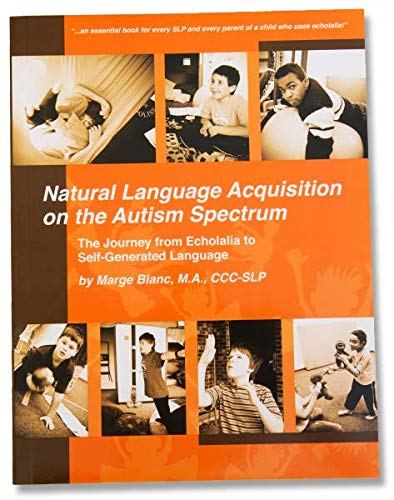The Gestalt Language Process: How to Use Music for Quick, Powerful Wins
- 0 comments
When it comes to making meaningful connections with children in the beginning stages of the gestalt language process, there is nothing as powerful as music. Music reaches gestalt language processors in such a dynamic way.
Tell me if this sounds familiar: your child, who has a speech delay, is playing in the living room. As they play, you notice a string of sounds that they seem to be repeating.
There’s an intonation to it, and there seems to be a clear rhythm. And that last part almost sounds like a word- was it the word “down”?
And then it hits you- they are actually singing “all through the town” from The Wheels on the Bus. Your child is singing!
Phrases from favorite songs often become the very first scripts of gestalt language learners. These scripts carry meaning, emotion, and connection for that child long before they sound clear to anyone else.
Part 1 of this series answered the question, “What is a gestalt language processor?”. In Part 2, we’ll look at how music supports this beautiful, natural language development path—and how you can music to help your child expand their communication through engagement, repetition, and redundancy.
If your child isn’t using many words yet, you may be unsure of what to do and what not to do- and you’re not alone. Many parents I coach in early intervention feel stuck, frustrated, or overwhelmed when their child won’t imitate their words.
That’s why I started creating music for speech therapy that weaves in the strategies we use everyday in early intervention.
You can download a free guide to discover 5 easy, parent-friendly steps to use songs for speech therapy to spark connection and communication with your child. As a bonus, you’ll receive song boards with cards for every First Words Dance Party™ song, so your child can make choices and initiate.
With that, let’s get into why music is so magical for gestalt language processors.
Why music is so beneficial for the gestalt language process
To a gestalt language processor, music is language in its most accessible, emotional, and memorable form. Gestalt language processors are known as “intonation babies” because they cue into the melody of language rather than honing in on individual words.
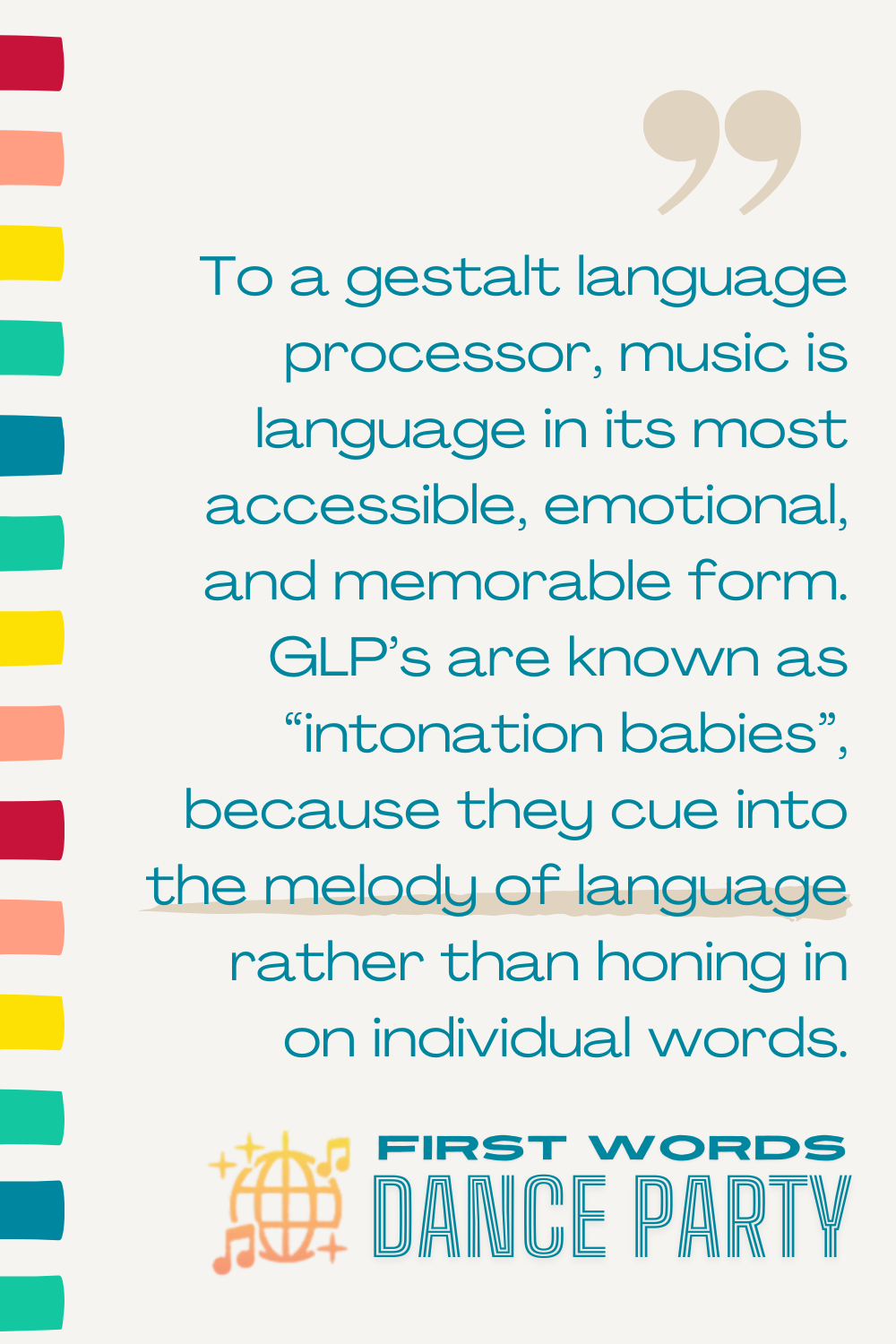
What is gestalt language processing?
Children who follow the progression of natural language acquisition, or the gestalt language process, learn to communicate by picking up whole chunks of language called gestalts.
They understand and use language in entire chunks instead of building their vocabularies one word at a time. Their gestalts are usually tied to emotion or a strong sensory experience, and few things deliver both more consistently than music.

Music has unique features that set it apart
Songs are naturally rich in features that support gestalt language processing:
Repetition: Song lyrics, especially in children’s songs, are naturally repetitive. The same phrases repeat multiple times, which helps them to stick.
Melody and prosody: The rhythm and tone of a song provide built-in cues that help children recognize and recall language, even if they can’t yet articulate the words clearly. In the example in the introduction, our kiddo marked each syllable in “All through the town” by making a sound for each syllable as they sang- even though the only word they could say clearly was “town”.
Emotional connection: Music carries emotional weight—and emotional connection is what helps gestalts stick.
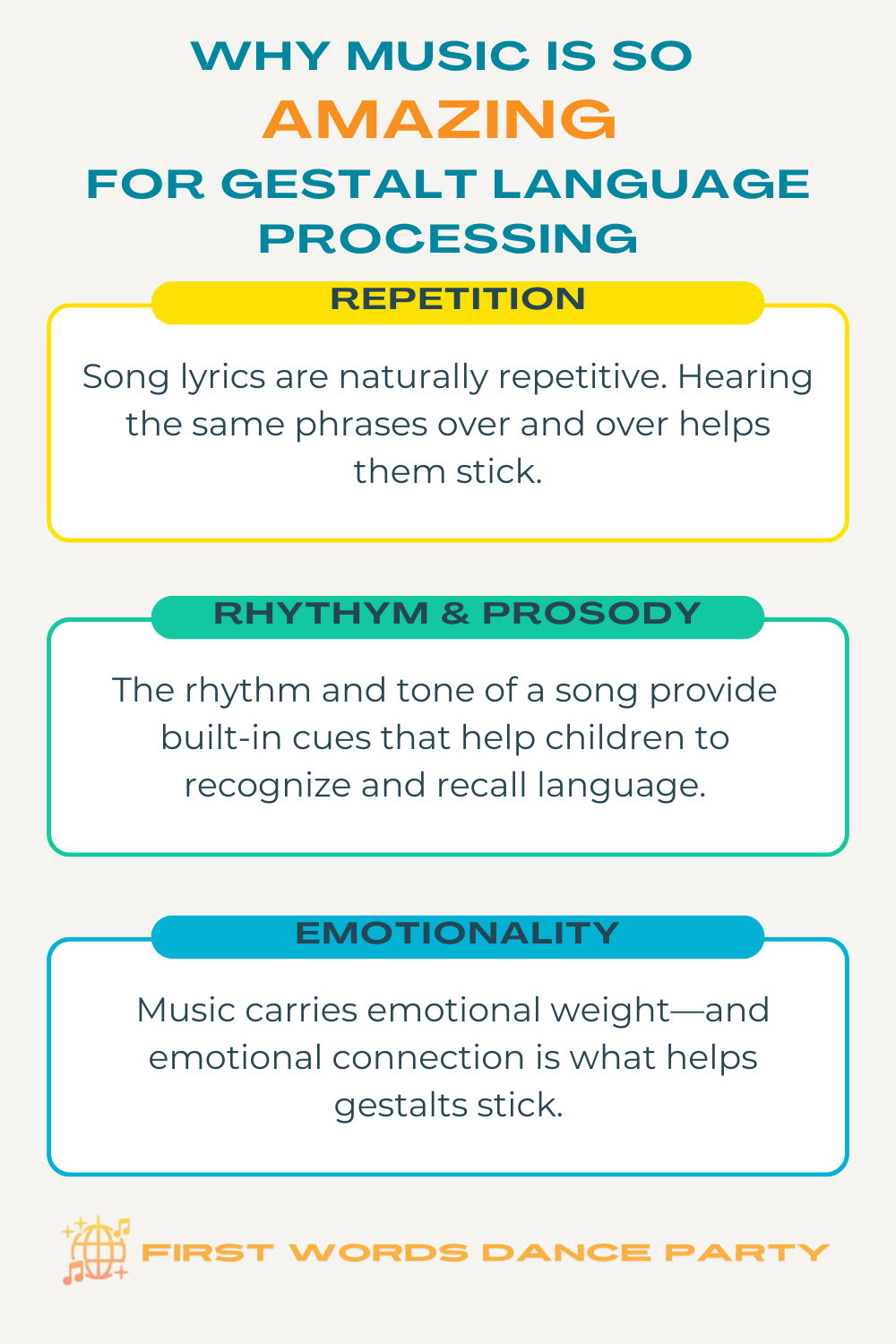
As Marge Blanc explains in her work on Natural Language Acquisition (NLA), children who follow the gestalt language process are not simply imitating—they are attaching meaning to chunks of language. Music makes those chunks easier to notice, repeat, and connect to daily life.
Gestalt language processing stages- seen through song
The gestalt language process unfolds in stages. These stages help us understand how a child moves from repeating full scripts—like favorite lines from songs—to creating flexible, self-generated speech.
Below, we’ll walk through each stage using gestalt language processing examples from The Wheels on the Bus and The Itsy Bitsy Spider. If your child sings these often, you’re already seeing the process in action.
Stage 1 – Whole Gestalts (Echolalia)
At this stage, children use entire phrases or “chunks” of language they’ve heard often—especially those tied to strong emotions, routines, or sensory experiences.
Example – The Wheels on the Bus:
A child sings “all through the town” every time they ride in the car or stroller. They may not pronounce every word clearly, but the melody and rhythm are unmistakable.Example – The Itsy Bitsy Spider:
A child quietly repeats “up the water spout” while playing with water or taking a bath.What You Can Do to Encourage Your Child’s Language: Model the full script in context. There’s no need to correct or break it down—just join in!
Stage 2 – Mixed Gestalts
Children begin blending parts of different scripts together, sometimes combining song phrases with language from daily routines or other favorite sources.
Example – The Wheels on the Bus:
A child might say “Daddy do beep beep beep!”, mixing “daddy do” from a family routine with “beep beep beep” from the song.Example – The Itsy Bitsy Spider:
A child combines lines or changes the order: “The very hungry caterpillar climbed up the water spout”, mixing “the very hungry caterpillar” with “up the water spout”.What You Can Do to Encourage Your Child’s Language: Echo their phrase or offer a small variation: “Itsy Bitsy Spider goes up, up, up!”
Stage 3 – Self-Generated Short Phrases
Children start forming short, original combinations. These phrases may still reflect patterns from earlier gestalts but are becoming more flexible.
Example – The Wheels on the Bus:
“Wheels on the bus song” or “Sing beep beep beep”Example – The Itsy Bitsy Spider:
“Itsy Bitsy again” or “Spider all done”What You Can Do to Encourage Your Child’s Language: Respond naturally and offer language-rich affirmations.
Stage 4 – Fully Self-Generated Language
Language becomes more flexible, fluent, and original. The child now creates spontaneous sentences but still draws on past experiences and favored phrases.
Example – The Wheels on the Bus:
“Mommy, let’s sing wheels on the bus.”Example – The Itsy Bitsy Spider:
“I see a spider up there!”.What You Can Do to Encourage Your Child’s Language: Let them lead—offer rich language models, but follow their interest.

How to teach gestalt language learners by capitalizing on music
Here is how to tap into your child’s love of music and their unique learning style to encourage communication skills.
1. Pay attention to the songs your gestalt language processor loves most
If your child likes to listen to the same songs over and over again, then you probably already have a pretty good idea of what the words are. That’s awesome! You’ll need to know at least parts of their favorites to get the most bang for your buck moving forward.
2. Pair Music With Movement
Try modeling actions to the songs. Movement reinforces rhythm, emotion, and engagement. Actions can be really engaging for little ones, and with time and repetition, they can gain valuable fine motor skills by imitating.
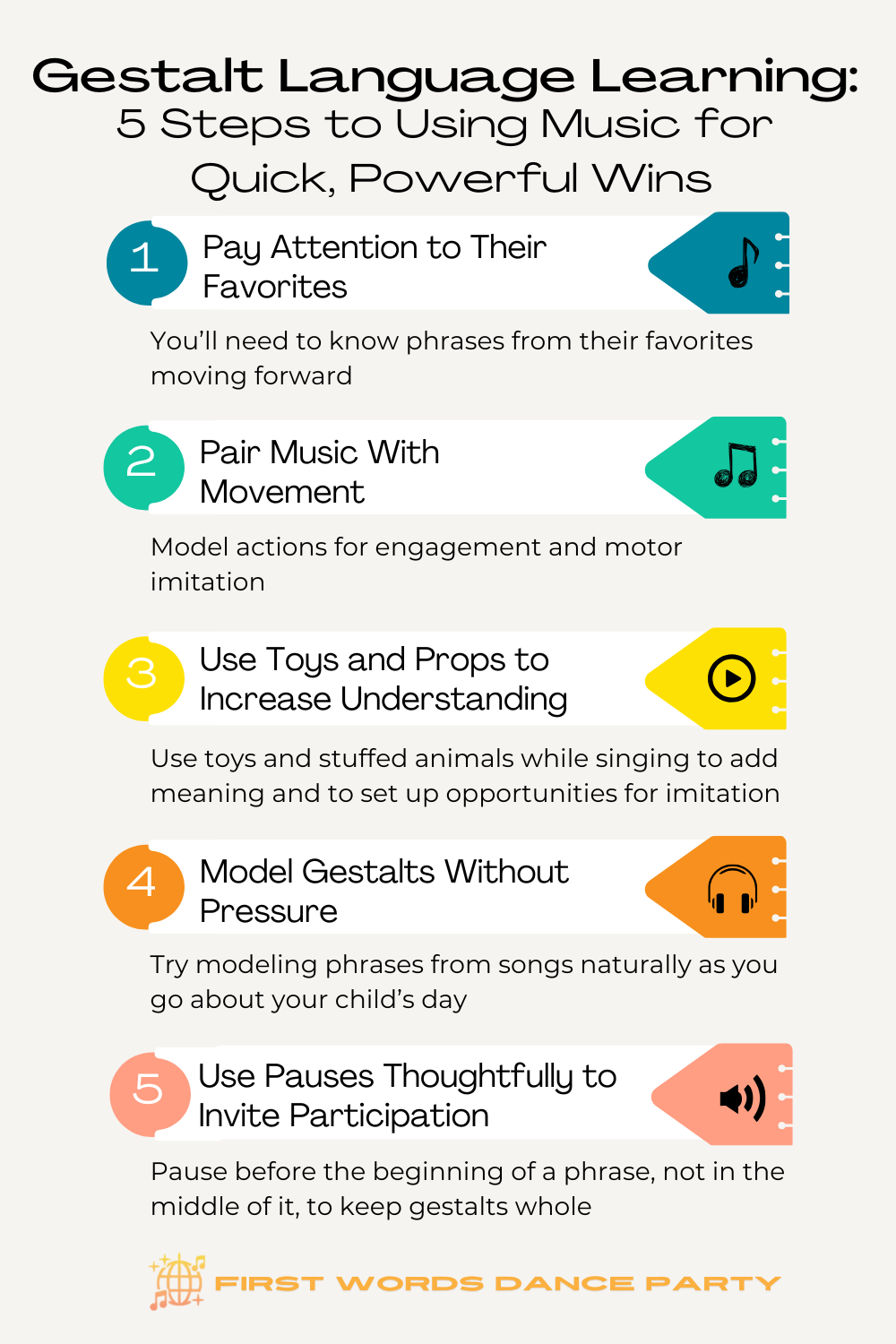
3. Pull in toys and stuffed animals to increase understanding
Gestalt language processors are often strong visual learners. Incorporating visuals into music time is a game changer for increasing joint attention (your child’s ability to focus on both you and an object). Since joint attention is a foundational skill for communication, this is a huge win!
You can incorporate visuals by using real objects you probably already have. The next time you sing Old McDonald, try using the animals from a toy farm set to increase your child’s understanding as you sing each verse (“And on that farm he had a horse, E-I-E-I-O”).
Try using a toy bus the next time you sing The Wheels on the Bus to point out the different parts (the lights, the wheels, the door, etc.) as you sing each verse.
Stuffed animals come in handy for any song about animals. Think 5 Little Monkeys, 5 Little Ducks, 4 Green and Speckled Frogs, etc. You don’t actually have to have five different stuffed monkeys- just use one and act out the lyrics in time with the music.
This offers a wonderful opportunity for your child to work on imitation when they have their own stuffed animal to hold, too!
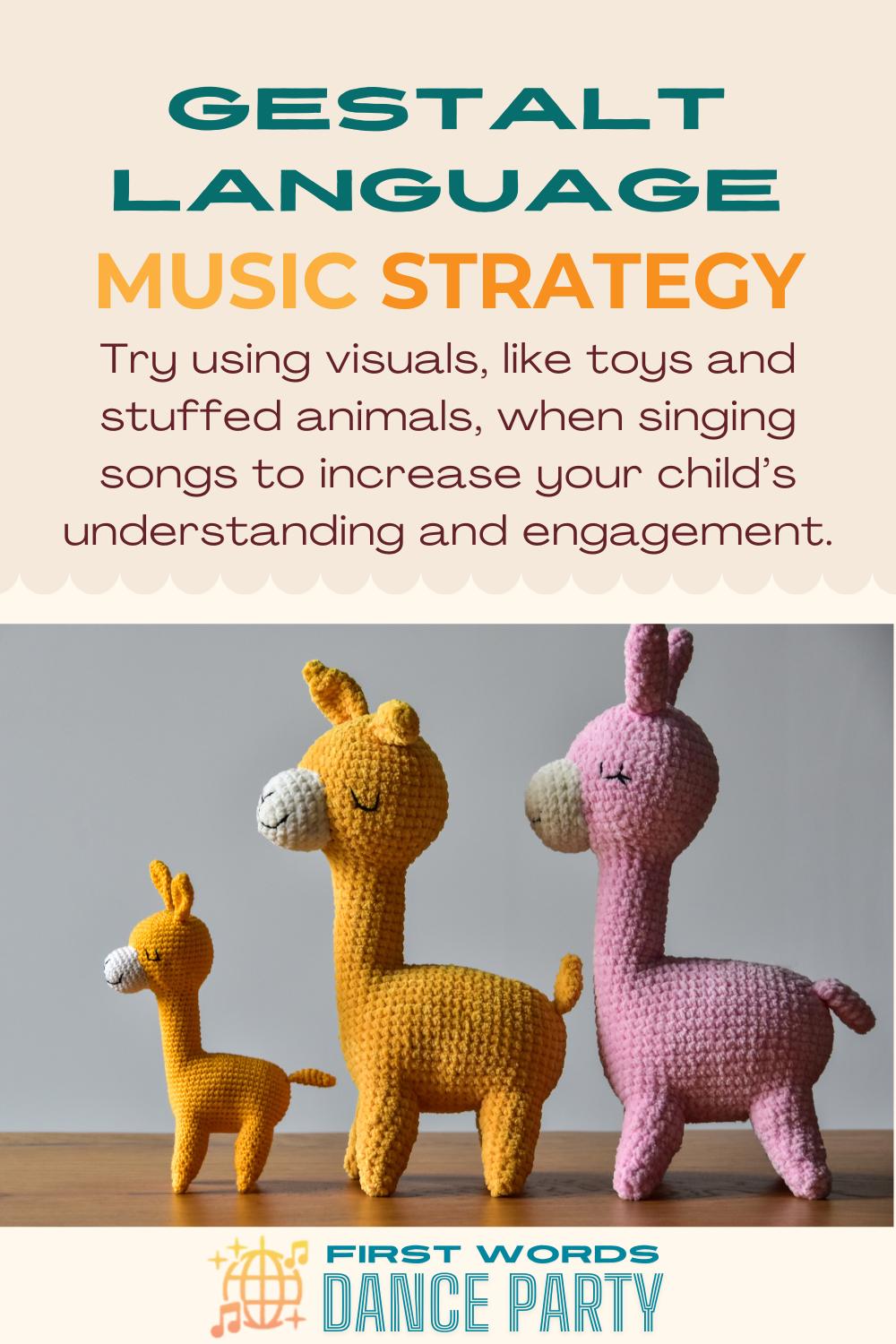
4. Model Gestalts Naturally Across Contexts
Ok, now this is where you’ll need to be intentional and creative- but you’ve got this.
Think of one of your child’s favorite songs. Are there any phrases from the song they already say? If so, how could you model that phrase in another context outside of music to honor their language and use it as a bridge?
I’m going to go back to our Wheels on the Bus example. Let’s say your kiddo echoes the phrase, “up and down” (from the verse, “the kids on the bus go up and down”). Try modeling “up and down” with the same melody, stress, and rhythm the next time your child’s arms are out as they hold their arms out to be picked up.
Now you’ve taken a script that is meaningful to them, and you’ve met your child where they are by offering redundancy (modeling the same gestalt across different contexts).
Now that you’ve got your child’s attention and they feel acknowledged, you can model a gestalt to target, like “Pick me up”. This will help your child to self-advocate with a gestalt that is easily mitigatable (i.e., easy to break up and combine with other words and phrases when your child has reached that stage of the gestalt language process).
Going back to our example, you could also model “up and down” before lifting your child to get them out of the swing, bathtub, or highchair.
Model without expecting your child to repeat you. Imitating on the spot can be really hard for gestalt language learners. So model the phrase and then be ok with the quiet that might follow.

5. Use Pauses Thoughtfully to Invite Your Gestalt Language Learner to Participate
Pausing can be a really powerful way to give your child an opportunity to join in. We just have to try to avoid pausing in the middle of a phrase.
Remember, kiddos who are in the beginning stages of the gestalt language process don’t only say language in whole chunks- they understand it in whole chunks, so pausing in the middle of a phrase will be harder than pausing before the start of it.
Try pausing before the start of a line, like this:
“The itsy bitsy spider…” (pause before “climbed up the water spout”)
“Down came the rain…” (pause before “and washed the spider out”)
“The doors on the bus go…” (pause before beep, beep, beep)
“Momma called the doctor and the doctor said…” (pause before “no more monkeys jumping on the bed”)
Notice that the pause happens before the start of a meaningful phrase. We avoided pausing in the middle or at the end, which would break up the gestalt.
When you pause before the start of a phrase, you invite engagement and open up opportunities for your child to join in while preserving the gestalt as a whole.
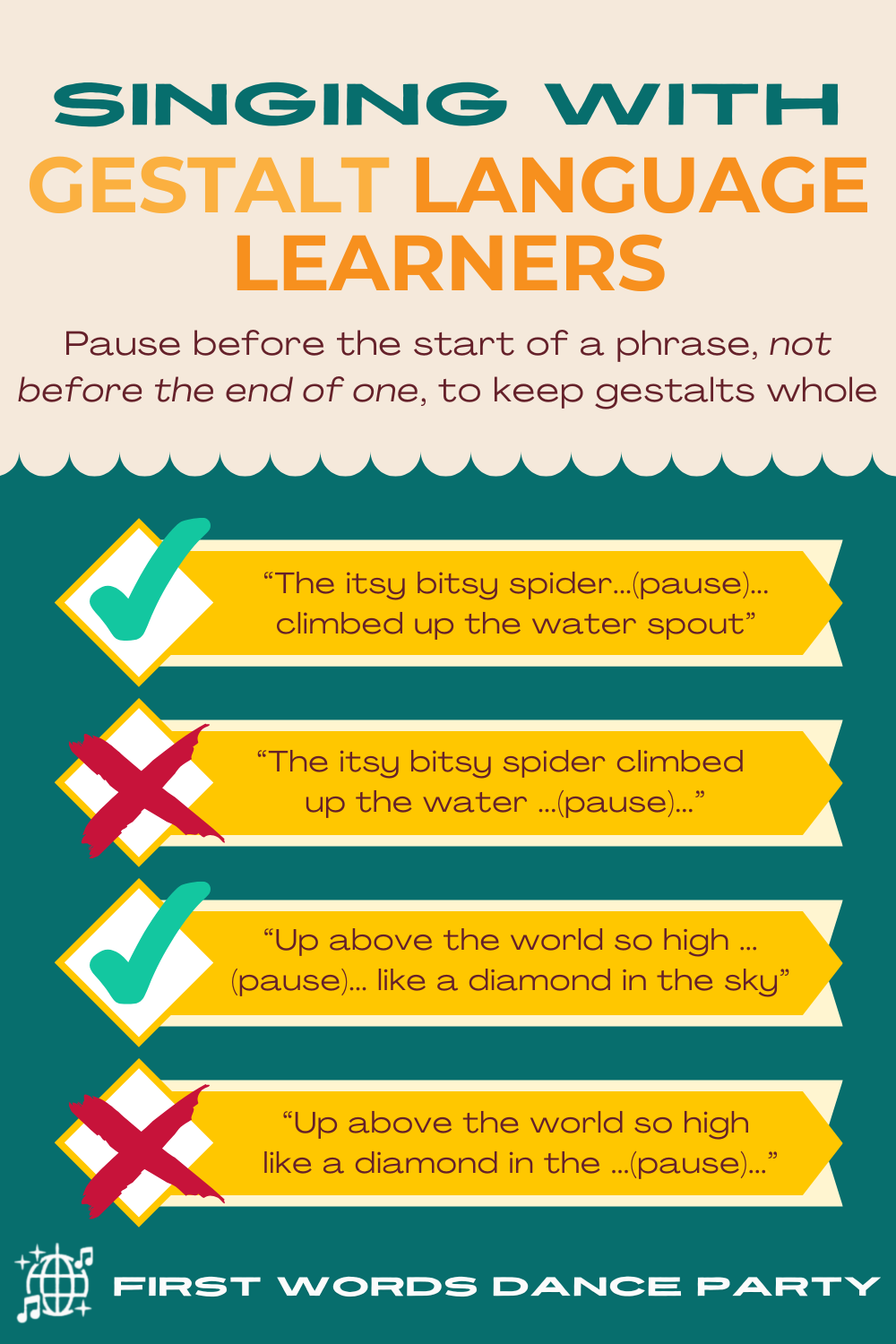
A Parent Resource Guide for Supporting the Gestalt Language Process Through Music
Here are some resources I highly recommend for parents looking for ways to support their gestalt language learners and music lovers.
First Words Dance Party: Catchy Songs and Music Videos for Gestalt Language Processors
First Words Dance Party is a fun, catchy collection of songs designed to support early language development. Each song models core vocabulary and words of the simplest syllable shapes, making the songs a powerful tool to help little ones imitate.
What makes First Words Dance Party especially helpful for gestalt language processors is the way each song is rich with naturally embedded scripts and phrases.
For children who learn language in chunks, not just words, these original songs provide ready-made, functional phrases that can be repeated, generalized, and eventually transformed into more flexible speech.
Here are a few examples:
“The Cookie Song”: A kid favorite that models the words yes and no with lots of repetition and rhythm, along with the phrases "I wanna eat", "I'm hungry", "Let's eat, please"
“Ready, Set, Go”: A super fun little number that models phrases like "I want more", "More bubbles", "Where'd it go?", and of course, "Ready, Set, Go!"
“What I Want”: This one targets phrases to self-advocate, like "I want to go outside", "open the door", "I want to eat chicken nuggets", and "I want water, please". Check out the core word video below to see how you can model AAC along with the songs. (Note that this core video YouTube series does use individual symbols to highlight core words at the single word level, versus using one symbol to represent an entire phrase.)
You can stream First Words Dance Party on Spotify, YouTube Music, Apple Music, and anywhere else you get your music.
Exclusive Upcoming Video Series
Ever feel like your child imitates things they see in videos, but it's almost impossible to get them to imitate you?
You're not alone. I can't tell you how many kiddos I've worked with who struggle to imitate, but there's something about watching a video that works some sort of magic.
It's what inspired me to create a brand new series of music videos that incorporate video modeling, AAC (Augmentative and Alternative Communication), and so much more.
Now, your child can experience the rhythmic, melodic gestalts in the songs as those scripts come alive with video modeling of real children engaging in real, daily routines.
This exclusive 10-video series brings each First Words Dance Party song to life with:
✅ Real children modeling language through daily routines like meals, playing with toys, and going to the playground
✅ Functional core words expressed through AAC, gestures, and sign language
✅ Aided language stimulation timed perfectly with the music
✅ Videos created specifically for gestalt language processors and children with speech delays
Unlike our free YouTube videos, these go far beyond lyrics. They show the "how"—how to use music to support expressive language, how to carry core words into real life, and how to use AAC to make language visible and accessible.
All in time with the lyrics of each song.
So you can experience the joy that comes with hearing your child say "up" and "help" for the first time. So your child can discover the power of their actions and their voice when you ask if they're hungry and they nod their head "yes".
Be the very first to know when the doors are opening by joining the waitlist.
Natural Language Acquisition on the Autism Spectrum by Marge Blanc
Natural Language Acquisition is a framework that explains how gestalt language processors develop and use language.
Blanc outlines gestalt language processing stages in her book, guiding families from those early scripts toward more flexible, self-generated speech. It’s a compassionate, research-informed way to nurture real communication by meeting your child where they are.
The Gestalt Language Processing Handbook, by Kathryn Arnold of Meaningful Speech

This handbook is a practical, easy-to-read guide for parents and professionals supporting gestalt language processors. It breaks down the stages of Natural Language Acquisition in clear, relatable terms and offers concrete strategies for gestalt language processing treatment.
With clear examples, visuals, handouts, and a compassionate tone, the handbook helps caregivers recognize and respond to their child’s script and emerging language. The handbook is available for download through the Meaningful Speech website and often accompanies their online course.
Let Them Lead: The Child-Led Autism Podcast with Nicole Casey
Music-Directed Speech Therapy for Gestalt Language Processors with Halle Demchuk
Let Them Lead: The Child-Led Autism Podcast with Nicole Casey is a podcast for professionals and caregivers looking for ways to support autistic kids with respect, trust, and connection. Nicole is an SLP who has made it her life’s work to support gestalt language processors.
In this episode, Nicole interviews Halle Demchuk, a speech language pathologist who uses an innovative approach to integrate music into speech therapy.
Halle emphasizes the significance of meaningful gestalts and how music can enhance language development across various stages. The conversation concludes with insights on the future of music therapy in language development and resources for further learning. This a fun and validating listen for any parent or professional.
Final Thoughts
There’s a saying that music is the universal language. When I think of the many children I’ve worked with whose very first words were lines from favorite songs, this saying feels so true.
When a child repeats a line from a song, it’s not “just” echolalia—it’s a step toward meaningful language. We can support gestalt language processors by tuning in to the songs and scripts that they find most meaningful and then modeling those scripts in other contexts.
Don’t forget to grab your free 5 Easy Steps to Kickstart Communication with Music for Speech Therapy at Home and take the first step toward connection and communication with your child.
Not only can we meet gestalt language learners where they are; with music, we can actually help move them along to the next stage of the gestalt language process.


